Topic 12: Vitamins
TLO: List the common vitamins and their sources and the problems associated with a deficit or excess
Introduction
Vitamins are organic nutrients that are required in small quantities (in micrograms to milligram quantities per day) for a variety of biochemical functions and which generally cannot be synthesized by the body and must, therefore, be supplied by the diet. Some of the vitamin can be synthesized by the intestinal microorganisms, but in quantities that does not meet our need sufficiently. Do recall the lesson from previous chapter about enzymes, many vitamins act as coenzymes whereby the combination of these vitamins with certain enzymes optimizes the enzyme activity for example formation of clotting proteins requires the presence of vitamin K.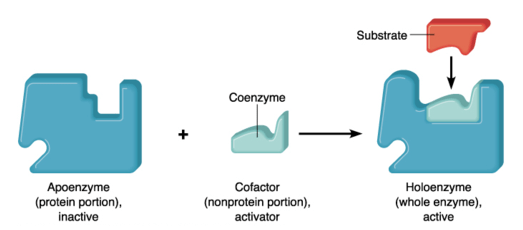
Figure 1 Vitamin acts as coenzyme to either activate or optimize the enzyme reaction. (source: www.pharmaguideline.com)
The vitamins are grouped into two categories based on their solubility:
Water soluble vitamins: absorbed with water along digestive tract, cannot be stored, any excess will be excreted in urine. Example of water-soluble vitamins are thiamine, riboflavin, biotin, niacin, folic acid, cyanocobalamin and ascorbic acid.
Fat soluble vitamins: combine with lipids and can be stored in the body (except for vitamin K). Since they can be stored in our adipose tissue, they have high risk of forming vitamin toxicity when accumulated. Example of fat-soluble vitamins are retinol (vitamin A), cholecalciferol (vitamin D), tocopherol (vitamin E) and phylloquinone (vitamin K).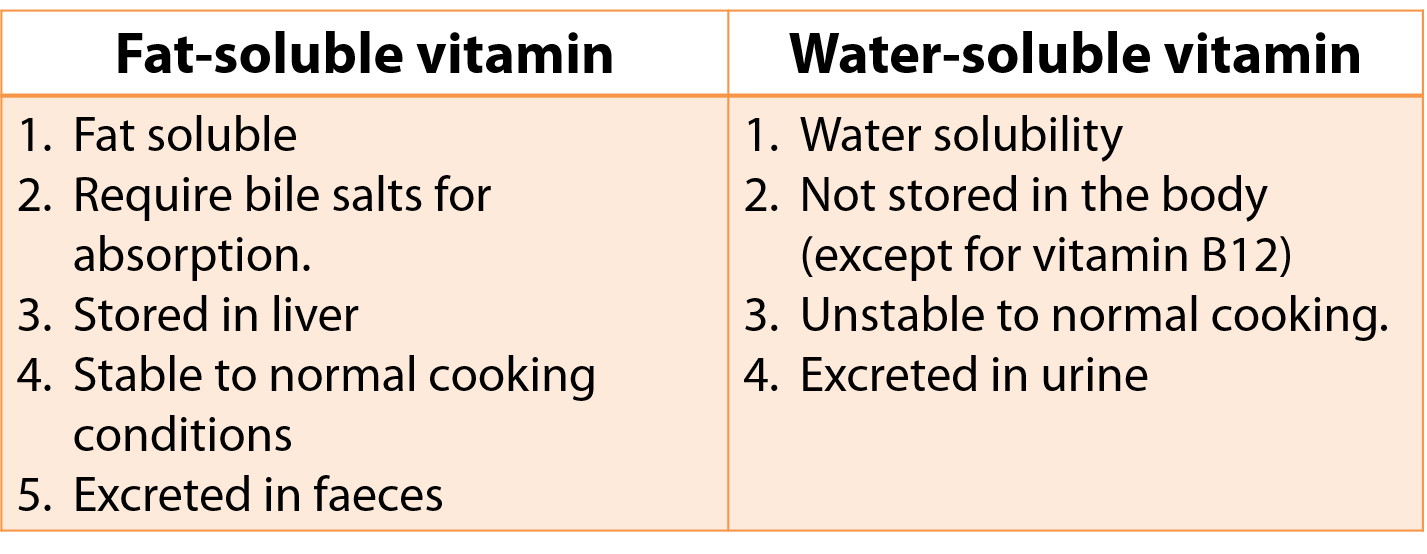
Table 1 showing the common properties of fat-soluble and water-soluble vitamins
FAT-SOLUBLE VITAMINS
Vitamin A
Chemistry
Vitamin A consists of three biologically active molecules which are collectively known as retinoids. Common form of vitamin A is retinol, retinal and retinoic acid. Each of these compounds are derived from the plant precursor molecule, β-carotene (also known as carotenoids).
Sources
The richest dietary sources of vitamin A are fish liver oils (cod liver oil). Animal’s liver are also rich sources but meat is rather low in vitamin A. Other good sources are milk and dairy products, dark green leaves, such as spinach and yellow and red fruits and vegetables, such as carrots, tomatoes, and peaches. The table below summarise the sources of vitamin A
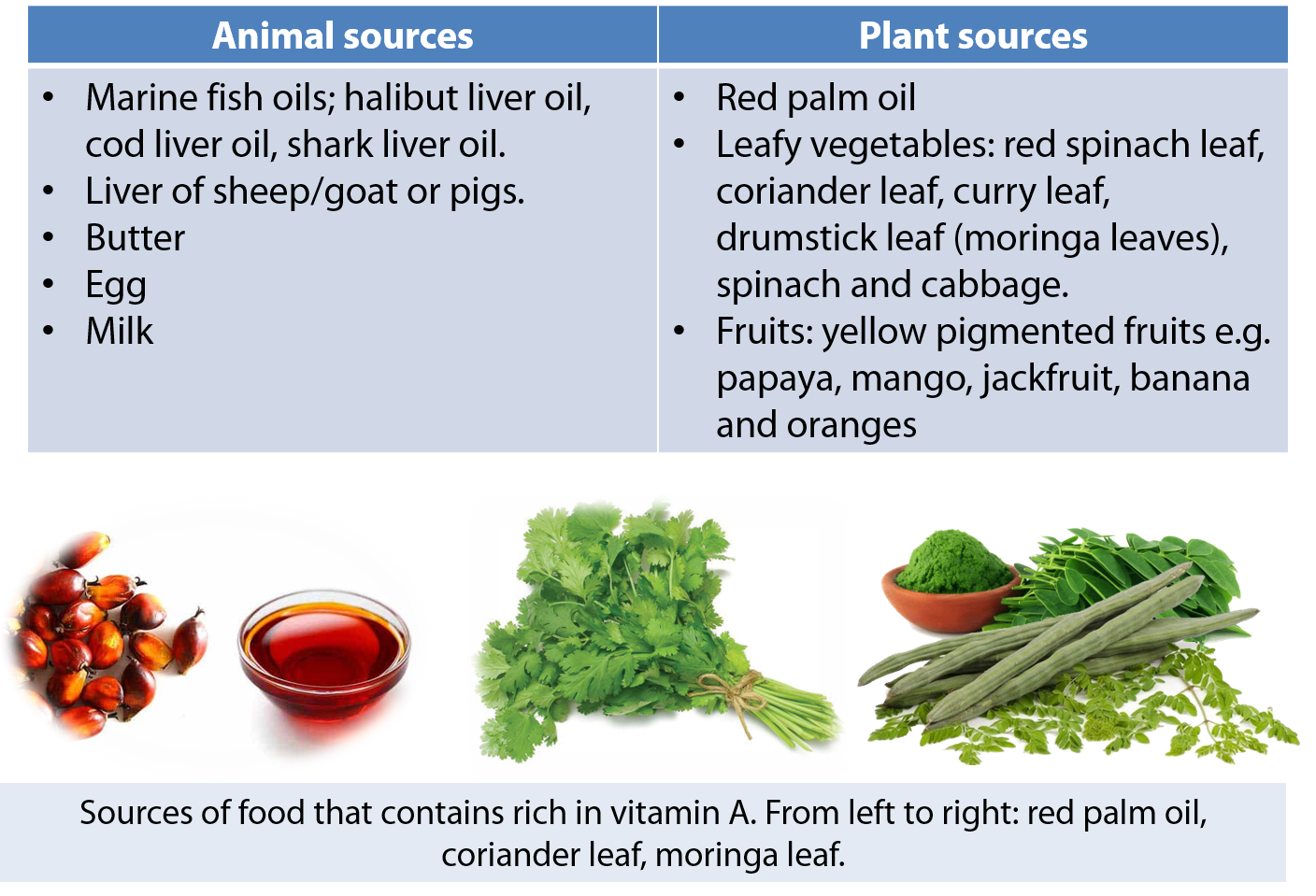
Functions
Different forms of the vitamin have different functions.
– Retinal and retinol are involved in vision.
– Retinoic acid is involved in cellular differentiation and metabolic processes.
– β-carotene is involved in antioxidant function.
The recommended daily allowance (RDA) of vitamin A for adults is 800–1000 retinol equivalents. (1 retinol equivalent = 1 µg retinol = 6 µg β-carotene).
Deficiency manifestations
Effect on vision: night blindness also known as nyctalopia. Night blindness is one of the earliest symptoms of vitamin A deficiency. This is characterized by loss of vision in night (in dim or poor light) since dark adaptation time is increased. Prolonged deficiency of vitamin A leads to an irreversible loss of visual cells. Severe vitamin A deficiency causes dryness of cornea and conjuctiva, a clinical condition termed as xerophthalmia (dry eyes). If this situation prolongs, keratinization and ulceration of cornea takes place. This results in destruction of cornea. The cornea becomes totally opaque resulting in permanent loss of vision (blindness), a clinical condition termed as keratomalacia. Xerophthalmia and keratomalacia are commonly observed in children. White opaque spots develop on either side of cornea in vitamin A deficiency are known as Bitot’s spot.
Figure 2 The difference between normal night vision and night blindness
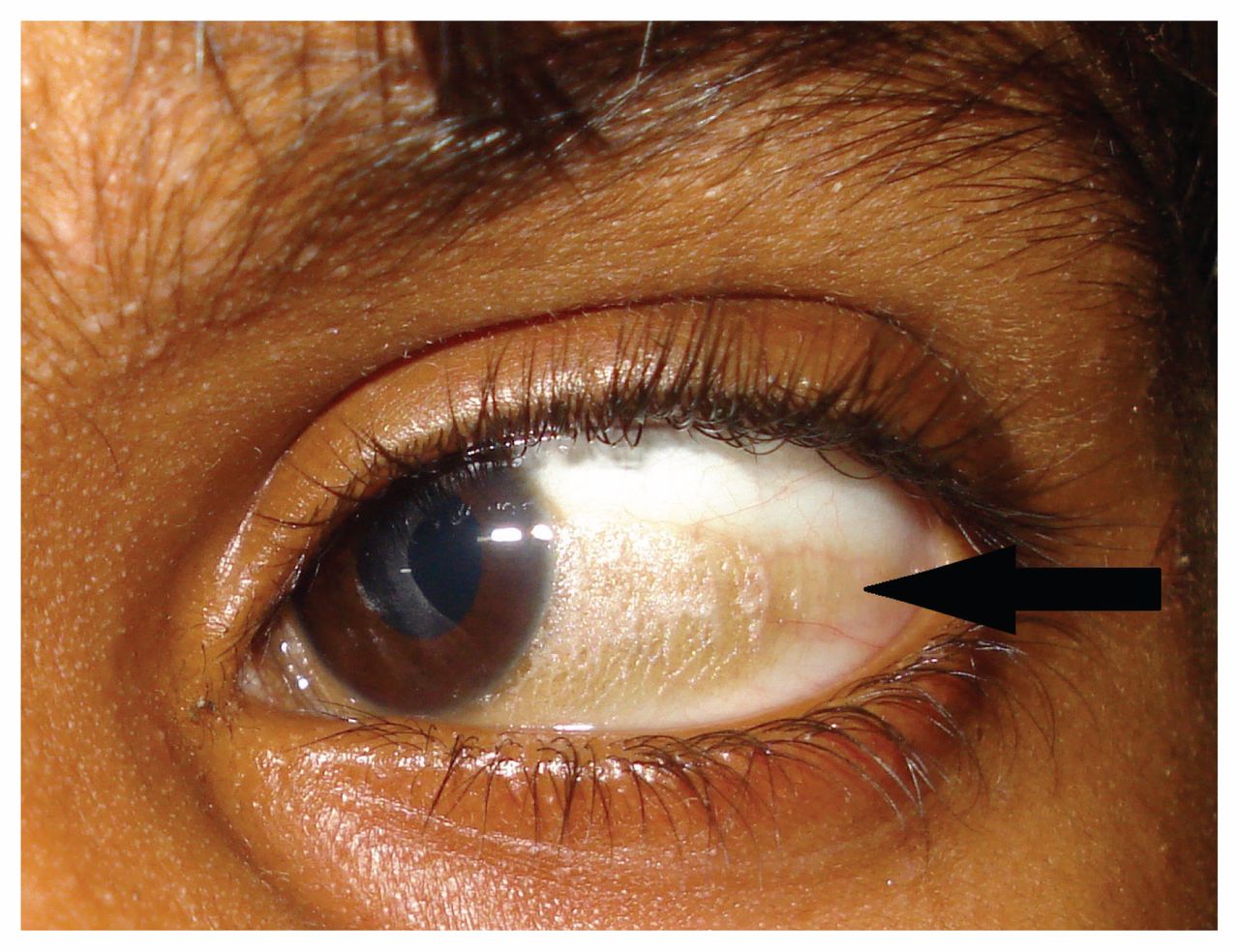
Figure 3 Bitot’s spot can be seen on the sclera. (source: https://www.cmaj.ca/content/189/40/E1264)
Effect on skin: Vitamin A deficiency causes keratinization of epithelial cells of skin which leads to keratosis of hair follicles, and dry, rough and scaly skin. Keratinization of epithelial cells of respiratory, urinary tract makes them susceptible to infections.
Other symptoms of vitamin A deficiency: Failure of growth in children, faulty bone modelling producing thick cancellous (spongy) bones instead of thinner and more compact ones, abnormalities of reproduction, including degeneration of the testes, abortion or the production of malformed offspring.
Toxicity manifestation (hypervitaminosis A)
The symptoms of hypervitaminosis A include nausea, vomiting, diarrhoea, loss of hair (alopecia), scaly and rough skin, bone and joint pain, enlargement of liver, loss of weight, etc. In pregnant women, the hypervitaminosis A may cause congenital malformation in growing foetus (teratogenic effect). The excess intake of carotenoids is not toxic like vitamin A.
VITAMIN D
Vitamin D is also known as calciferol because of its role in calcium metabolism and anti-rachitic factor because it prevents rickets.
Chemistry
Vitamin D is a steroid compound. There are two forms of vitamin D.
1. The naturally produced D3 or cholecalciferol, is the form obtained from animal sources in the diet, or made in the skin by the action of ultraviolet light from sunlight on 7-dehydrocholesterol.
2. Artificially produced form D2 or ergocalciferol, is the form made in the laboratory by irradiating the plant sterol, ergosterol.
Sources
Best sources are cod liver oil and often fish oils and sunlight induced synthesis of vitamin D3 in skin. Egg yolk and liver are good sources. The table below summarises the sources of food that are rich in vitamin D.
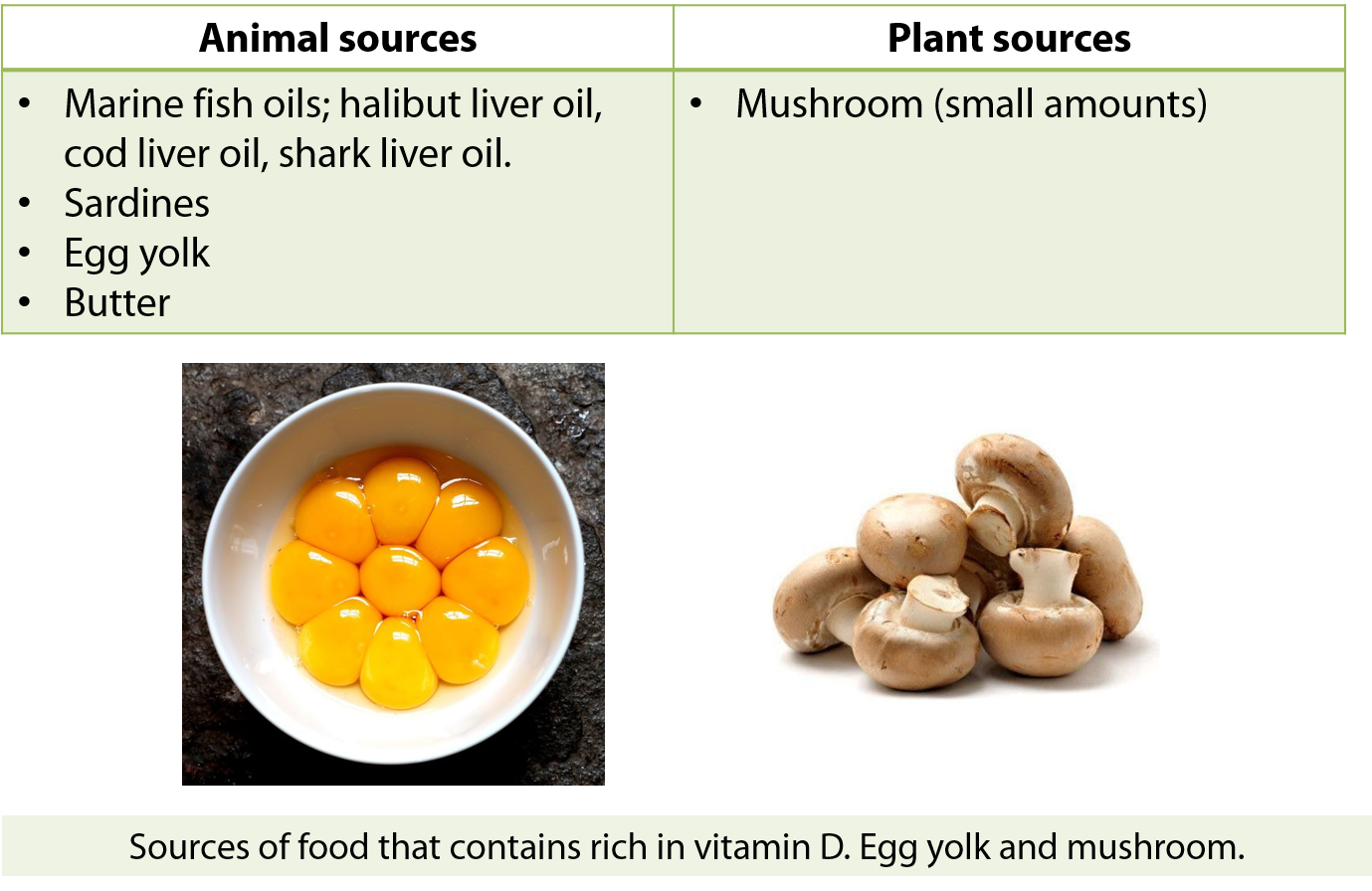
Functions
Vitamin D (Calcitriol) plays an essential role as a hormone in the regulation of calcium and phosphorus metabolism. It maintains the normal plasma level of calcium and phosphorus by acting on intestine, kidneys and bones.
The daily requirements of vitamin D is 200-400IU.
Deficiency manifestations
Rickets: Rickets is characterized by formation of soft and pliable bones due to poor mineralization and calcium deficiency. Due to softness, the weight bearing bones are bent and deformed. The main features of the rickets are, a large head with protruding forehead, pigeon chest, bow legs, (curved legs), knock knees and abnormal curvature of the spine (kyphosis). Rachitic children are usually anaemic or prone to infections. Rickets can be fatal when severe. Rickets is characterized by low plasma levels of calcium and phosphorus and high alkaline phosphatase activity.
Osteomalacias (adult rickets): The deficiency of vitamin D in adults causes osteomalacia. This is a condition similar to that of rickets. Osteomalacia characterized by demineralization of previously formed bones, Demineralization of bones makes them soft and susceptible to fractures.
Vitamin D toxicity (hypervitaminosis D)
High doses of vitamin D over a long period are toxic. The early symptoms of hypervitaminosis D include nausea, vomiting, anorexia, increased thirst, loss of weight, etc. Hypercalcemia is seen due to increased bone resorption and intestinal absorption of calcium. The prolonged hypercalcemia causes calcification of soft tissues and organs such as kidney and may lead to formation of stones in the kidneys.
Vitamin E
Chemistry
Vitamin E consists of eight naturally occurring tocopherols that includes alpha-tocopherol, beta-tocopherol, delta-tocopherol and gamma-tocopherol, of which α-tocopherol is the most active form.
Sources
The major dietary sources of vitamin E are fats and oils. The richest sources are germ oil, corn oil, fish oil, eggs, lettuce and alfalfa. The table below summarize the food that contains high amount of vitamin E.
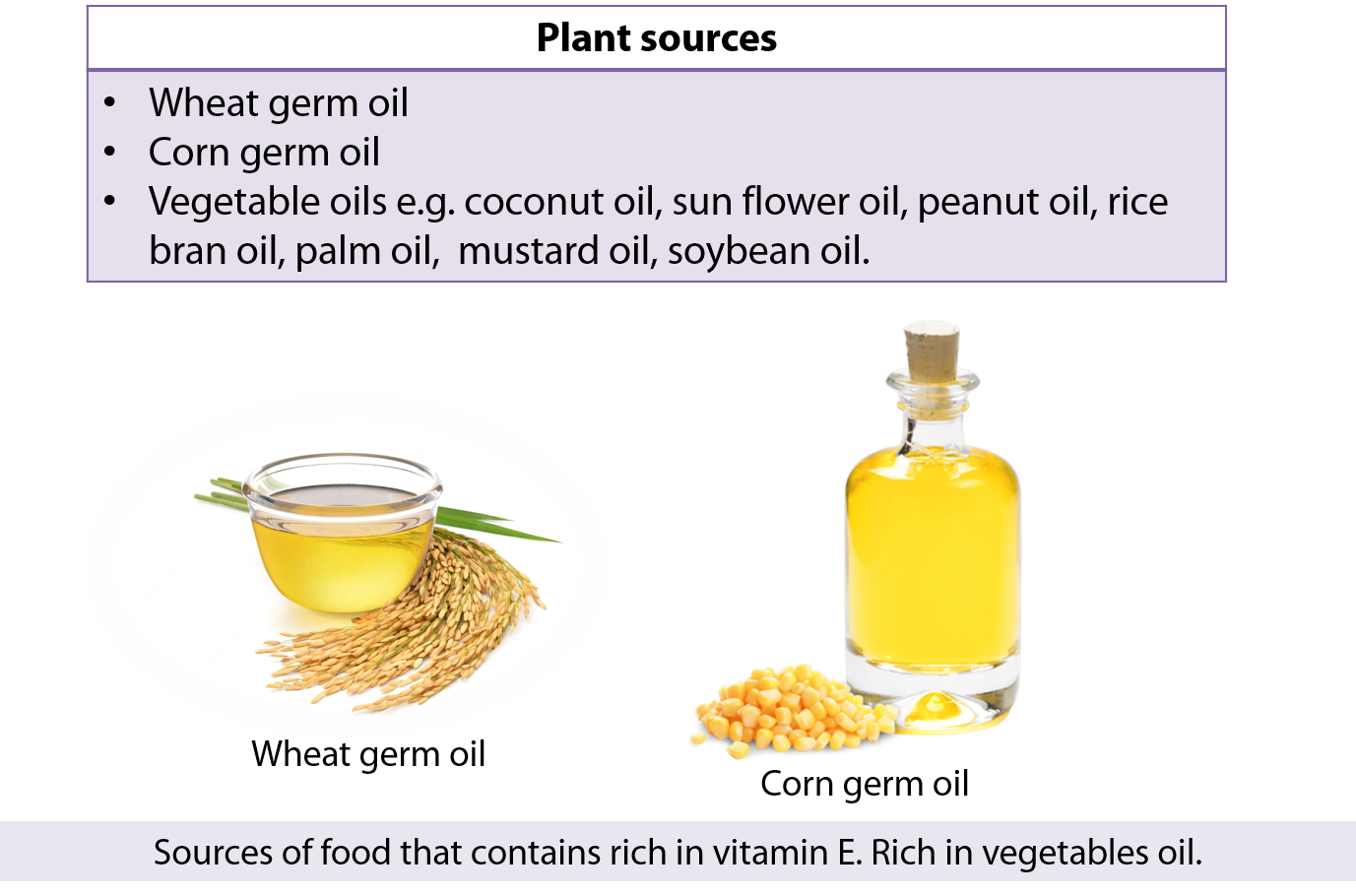
The daily recommended consumption for vitamin E is about 10 mg (15 IU) of α-tocopherol for a man and 8 mg (12 IU) for a woman.
Functions
Vitamin E acts as a natural antioxidant by scavenging free radicals and molecular oxygen. Vitamin E is also important for preventing peroxidation of polyunsaturated fatty acids in cell membranes. Other than that, protection of erythrocyte membrane from oxidant is the major role of vitamin E in humans by protecting the red blood cell (RBCs) from haemolysis. Vitamin E also helps to prevent oxidation of LDL. Oxidized LDL may be more atherogenic than native LDL and thus vitamin E may protect against atheromatous coronary heart disease.
Deficiency manifestations
Vitamin E deficiency in humans is rare. The major symptom of vitamin E deficiency in human is hemolytic anemia due to an increased red blood cell fragility. Another symptom of vitamin E deficiency is retrolental fibroplasia (RLF) observed in some premature infants of low birth weight. Children with this defect show neuropathy.Toxicity vitamin E (hypervitaminosis E)
Unlike other fat-soluble vitamins such as A and D, vitamin E does not seem to have toxic effects.Vitamin K
Chemistry
This vitamin is called an anti-haemorrhagic factor as its deficiency produced uncontrolled haemorrhages due to defect in blood coagulation. There are two naturally occurring forms of vitamin K that includes Vitamin K1 or phylloquinone derived from plant and vitamin K2 or menaquinones, produced by microorganisms. Both these natural types have the same general activity. Vitamin K3 or menadione is a synthetic product, which is an alkylated form of vitamin K2.
Sources
Excellent sources are cabbage, cauliflower, spinach and other green vegetables. Good sources include tomatoes, cheese, dairy products, meat, egg yolk, etc. The vitamin is also synthesized by microorganisms in the intestinal tract. The table below summarise the foods that contain rich amount of vitamin K.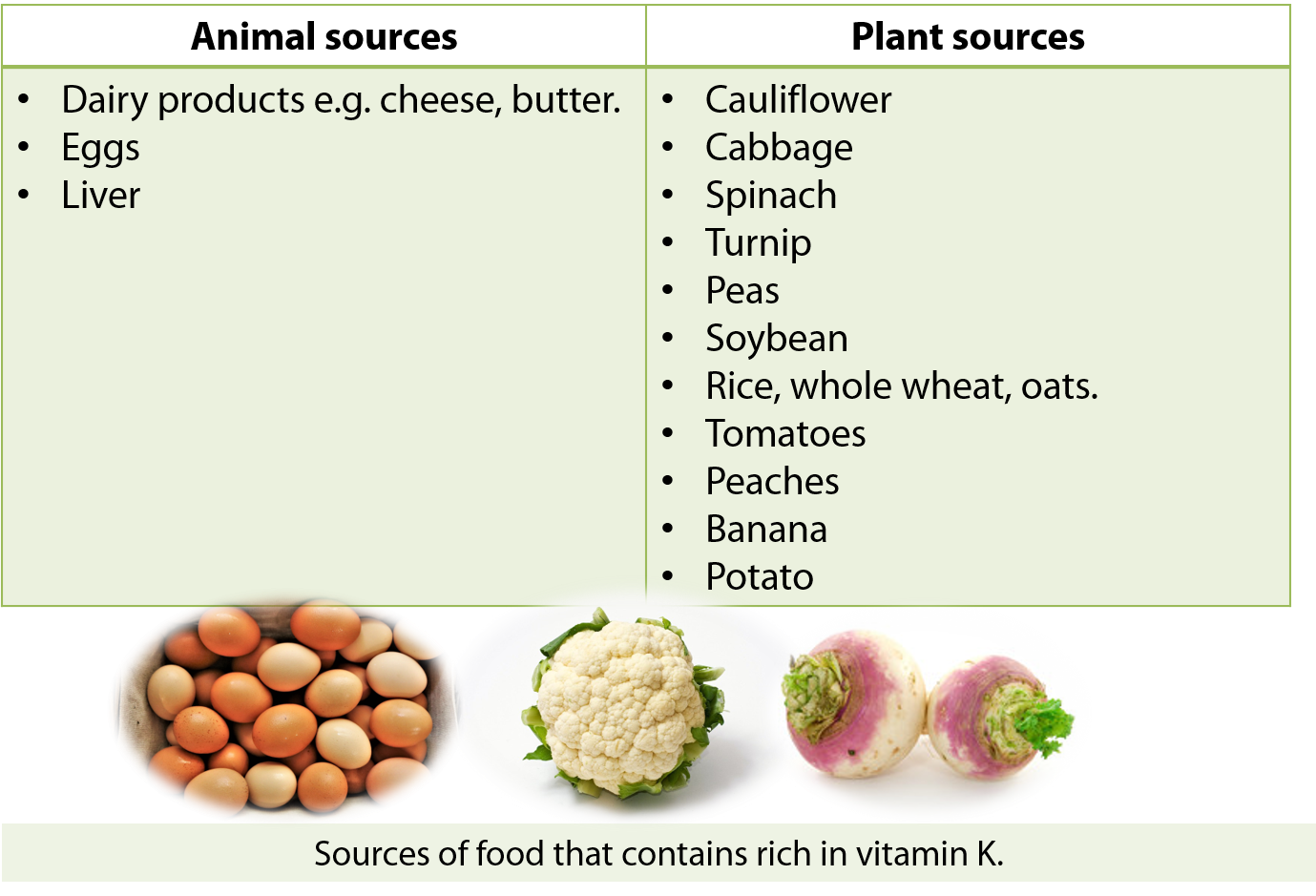
The suggested intake for adults is 70–140 μg/day.
Functions
Vitamin K plays an important role in blood coagulation. Vitamin K is required for the activation of blood clotting factors, prothrombin (II), factor VII, IX and X. These blood clotting proteins are synthesized in liver in inactive form, and are converted to active form by vitamin K dependent carboxylation reaction. In this, vitamin K dependent carboxylase enzyme adds the extra carboxy group at χ-carbon of glutamic acid residues of inactive blood clotting factors. Vitamin K is also required for the carboxylation of glutamic acid residues of osteocalcin, a Ca2+ binding protein present in bone.
Deficiency manifestations
Vitamin K deficiency is associated with haemorrhagic disease. In vitamin K deficiency, clotting time of blood is increased. Uncontrolled haemorrhages occur on minor injuries as a result of reduction in prothrombin and other clotting factors. Vitamin K is widely distributed in nature and its production by the intestinal microflora ensures that dietary deficiency does not occur. Vitamin K deficiency, however, is found in:
Patients with liver disease and biliary obstruction. Biliary obstruction inhibits the entry of bile salts to the intestine.
In newborn infants, because the placenta does not pass the vitamin to the fetus efficiently, and the gut is sterile immediately after birth.
Following antibiotic therapy that sterilizes the gut.
In fat malabsorption, that impairs absorption of vitamin K.
Toxicity of vitamin K (hypervitaminosis K)
Excessive doses of vitamin K produce a haemolytic anaemia (due to increased breakdown of RBCs) and jaundice (in infants).